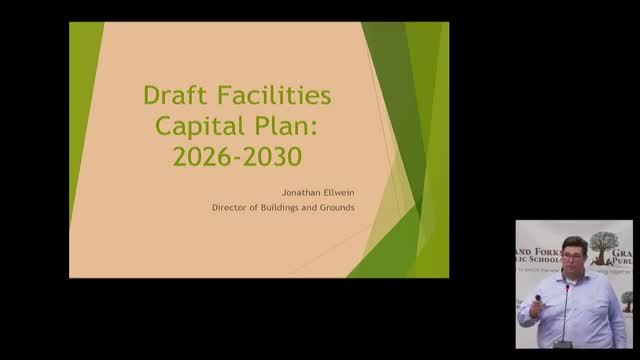School Board Approves $8M Capital Projects Including Schrader Roof Restoration
September 23, 2025 | GRAND FORKS 1, School Districts, North Dakota
This article was created by AI summarizing key points discussed. AI makes mistakes, so for full details and context, please refer to the video of the full meeting. Please report any errors so we can fix them. Report an error »

In a recent meeting of the Grand Forks Public Schools Facilities Committee, significant discussions centered around a proposed $8.4 million investment aimed at addressing critical infrastructure needs across 15 schools. The plan outlines 44 projects, with a strong emphasis on essential repairs and upgrades, particularly focusing on roofing, flooring, and HVAC systems.
One of the most pressing projects highlighted was the roof restoration at Schrader Middle School, which is considered a top priority due to its deteriorating condition. The committee proposed allocating approximately $1.25 million in the first year to initiate this project alongside other flooring updates. The urgency of addressing the roof was underscored by committee members, who expressed concerns about potential further damage if repairs were delayed.
The discussion also included a detailed breakdown of future projects scheduled for 2026 through 2029. For instance, in 2027, the committee plans to invest around $1.7 million for repairs at Wilder and Central schools, including a long-deferred skylight repair. The strategy for flooring replacement was also revised, with a new model proposed to ensure that funds are allocated effectively across the district, preventing a backlog of flooring issues.
A significant point of contention arose regarding the long-term viability of Schrader Middle School. Committee members debated whether continued investment in repairs was prudent or if it would be more beneficial to consider building a new facility. The threshold for determining whether to renovate or replace a school was discussed, with a benchmark set at 50% of the cost of a new building. For Schrader, this figure was estimated at approximately $27.5 million, raising questions about the future of the school as repairs continue.
The committee's discussions reflect a broader concern about the aging infrastructure within the district and the need for strategic planning to ensure that investments are made wisely. As the district moves forward with these projects, the implications for students, staff, and the community at large will be significant, particularly in terms of safety, comfort, and educational quality.
Looking ahead, the committee will continue to evaluate the effectiveness of these investments and the potential need for larger capital projects, including the possibility of constructing new facilities if current schools are deemed beyond repair. The next steps will involve further analysis of the proposed projects and ongoing discussions about the best path forward for the district's educational infrastructure.
One of the most pressing projects highlighted was the roof restoration at Schrader Middle School, which is considered a top priority due to its deteriorating condition. The committee proposed allocating approximately $1.25 million in the first year to initiate this project alongside other flooring updates. The urgency of addressing the roof was underscored by committee members, who expressed concerns about potential further damage if repairs were delayed.
The discussion also included a detailed breakdown of future projects scheduled for 2026 through 2029. For instance, in 2027, the committee plans to invest around $1.7 million for repairs at Wilder and Central schools, including a long-deferred skylight repair. The strategy for flooring replacement was also revised, with a new model proposed to ensure that funds are allocated effectively across the district, preventing a backlog of flooring issues.
A significant point of contention arose regarding the long-term viability of Schrader Middle School. Committee members debated whether continued investment in repairs was prudent or if it would be more beneficial to consider building a new facility. The threshold for determining whether to renovate or replace a school was discussed, with a benchmark set at 50% of the cost of a new building. For Schrader, this figure was estimated at approximately $27.5 million, raising questions about the future of the school as repairs continue.
The committee's discussions reflect a broader concern about the aging infrastructure within the district and the need for strategic planning to ensure that investments are made wisely. As the district moves forward with these projects, the implications for students, staff, and the community at large will be significant, particularly in terms of safety, comfort, and educational quality.
Looking ahead, the committee will continue to evaluate the effectiveness of these investments and the potential need for larger capital projects, including the possibility of constructing new facilities if current schools are deemed beyond repair. The next steps will involve further analysis of the proposed projects and ongoing discussions about the best path forward for the district's educational infrastructure.
View full meeting
This article is based on a recent meeting—watch the full video and explore the complete transcript for deeper insights into the discussion.
View full meeting
